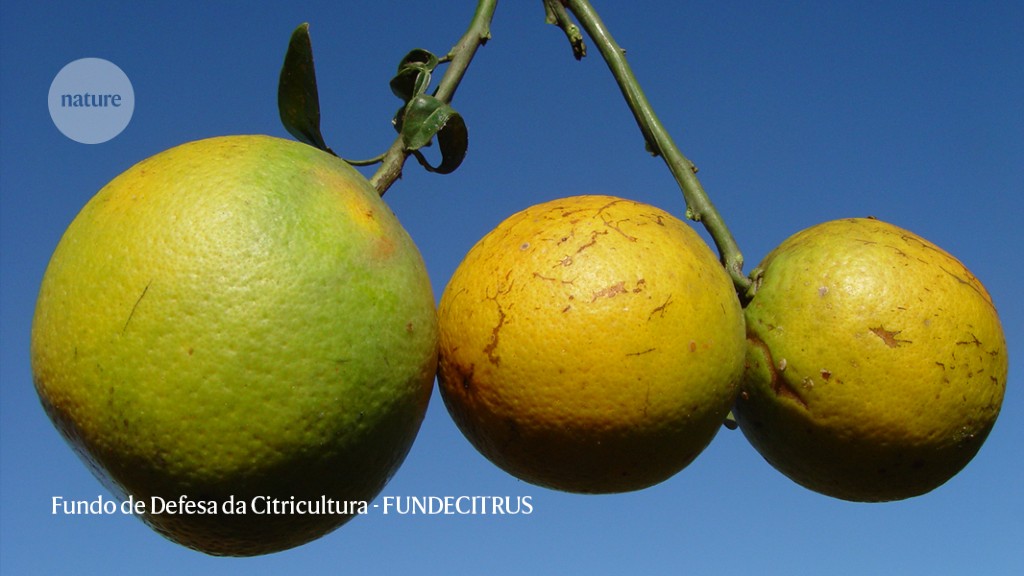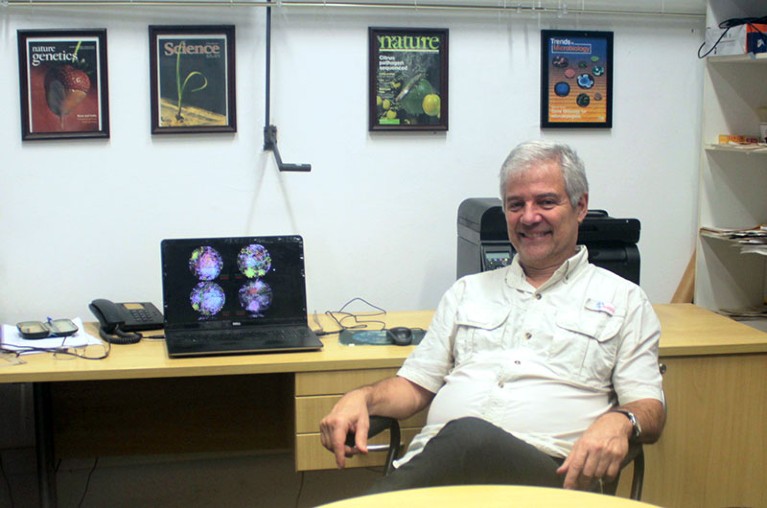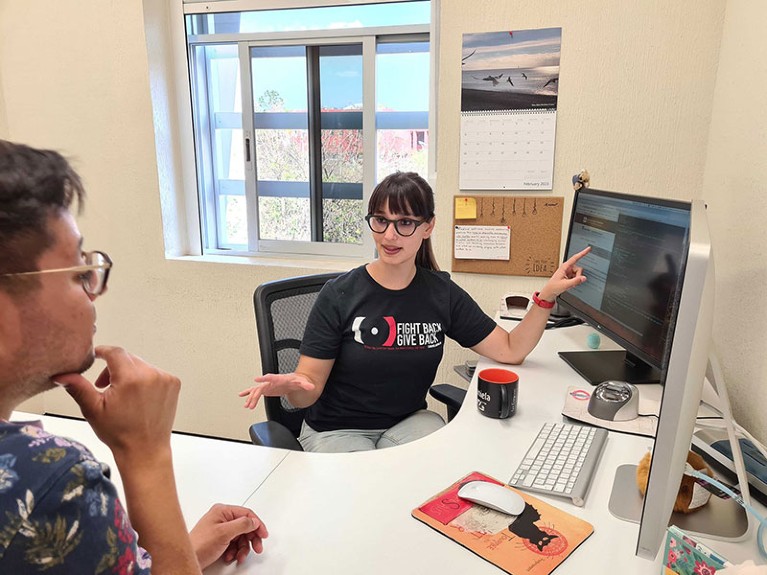Citrus trees can be infected with the bacterium Xylella fastidiosa. Its genome was sequenced by a Brazilian team in 2000.Credit: Courtesy of Fundo de Defesa da Citricultura – FUNDECITRUS
Daniela Robles-Espinoza was a first-year undergraduate at the National Autonomous University of Mexico’s (UNAM’s) newly established Center for Genomic Sciences in Cuernavaca when she got a front-row seat to the dawn of genomics in her country.
The year was 2005. Scientists in Cuernavaca, nestled in the highlands 50 kilometres southwest of Mexico City, led a government-funded project to sequence the genome of Rhizobium etli, a bacterium that lives on the roots of some bean plants, helping them to fix nitrogen. Mirroring a Brazilian effort at the University of São Paulo to sequence the bacterial plant pathogen Xylella fastidiosa five years earlier, the project was an ambitious attempt to build up the country’s biotechnology infrastructure, providing Robles-Espinoza and her fellow students with an opportunity to watch cutting-edge genomics at first hand.
“I had this perception that if you want to do good science, you have to go abroad,” says Robles-Espinoza, who is now a group leader at UNAM’s International Laboratory for Human Genome Research in Querétaro, 200 km northwest of Mexico City. “It was kind of in the air that people want to leave. But I would say, not any more.”
Two decades later, the sequencing of a bacterium no longer sounds like much of a milestone, but with a US$11.6-million grant from the São Paulo government, the project’s leaders say the X. fastidiosa research received more state funding than any other single piece of Brazilian science. The Mexican project received $2 million, also a major investment. To scientists across South and Central America, these projects represented more than just a loosening of governmental purse strings. By funding Mexican and Brazilian scientists to sequence agriculturally important bacteria, which were significant to their own economies, the projects have helped to spark the region’s biotech revolution.
The X. fastidiosa work “created a network and a buzz within the São Paulo community. That was really important”, says Lygia da Veiga Pereira, director of the National Laboratory for Embryonic Stem Cell Research at the University of São Paulo. “The greatest impact was in making these tools more available — not just sequencing but also molecular biology.”
Collection: Young scientists
Both Mexico and Brazil’s initial, time-limited sequencing projects also helped to train a new generation of genomics researchers, says Rafael Palacios, one of the directors of the R. etli sequencing effort and coordinator of UNAM’s International Laboratory for Human Genome Research. Mexico created a specialized undergraduate programme for future geneticists. And, in Brazil, the number of students earning master’s- and doctoral-level degrees in science doubled between 2000 and 2008 (see go.nature.com/3rfim1e).
Yet without greater investment, those gains are in danger. Although some large institutes have secured sustainable funding, not all researchers are so lucky. Brazil’s former president Jair Bolsonaro repeatedly cut science funding during his administration; in 2021, Brazil’s science budget was 4.4 billion reais (US$852 million), compared with 14 billion reais in 2015, the country’s peak. Researchers hope that Brazil’s newly elected president, Luiz Inácio Lula da Silva, who took office on 1 January, will reverse this trend. Mexico invests less than 1% of its gross domestic product in scientific research1 (compared with more than 3% in the United States and nearly 5% in Israel), and according to the World Bank, Mexico has just 327 scientists for every one million people (compared with 4,821 per million in the United States). Still, both Brazil and Mexico host small but vibrant biotech communities, says Palacios.
“There are very good scientists doing very good genomics in Mexico,” says Palacios. “They are the ones that will change the image of Mexican genomics.”
International sprint
From his office in sprawling São Paulo, Fernando Reinach watched a revolution unfold.
By the mid-1990s, US and European researchers had begun making huge strides in genome sequencing — first the laboratory bacterium Escherichia coli, then the nematode worm, the fruit fly and a flowering plant. At the same time, two international teams were racing to complete the human genome. As the biochemistry coordinator at the São Paulo Research Foundation (FAPESP), the scientific funding agency for the state of São Paulo, Reinach wanted to spark a revolution of his own. But this one would be completely Brazilian.
“In these new areas where fields were booming, it was clear that Brazil was being left behind,” says Reinach. “There were just two to three people in Brazil who were able to sequence a genome.”
Brazil election: Scientists cheer Lula victory over Bolsonaro
The country had geneticists and bioinformaticians, but most of them trained abroad and in many cases stayed there. Those who returned often collaborated on European or US projects rather than leading their own. Fuelled by optimism and a desire to prove his country’s scientific mettle on the global stage, in 1997 Reinach invited 191 scientists from across São Paulo to participate in the sequencing and analysis of the bacterium X. fastidiosa.
The bacterium causes citrus variegated chlorosis, a disease that has infected more than 100 million citrus trees in Brazil since 1987. Yet, although scientists had begun to tackle human-associated bacteria, no one had yet sequenced a plant pathogen. Previous work had shown that X. fastidiosa had a genome of 2.7 million base pairs. That placed it in the genomics Goldilocks zone: enough DNA to challenge scientists but small enough to be manageable.
Steven Lindow, a microbiologist at the University of California, Berkeley, recalls wondering about the project’s expense. “I knew it could be worthwhile, but it was also hideously expensive,” he says. But in less than two years, the Brazilian team had sequenced, annotated and analysed the X. fastidiosa genome, on time and under budget. (It took a team of researchers five-and-a-half years to sequence E. coli2.) The resulting paper3 was published on 13 July 2000, just months after the human genome, and made the cover of Nature. João Carlos Setubal, a bioinformatics researcher at the University of São Paulo who co-led the project, says this might have been a first for Brazilian scientists.
“The simple fact that a group of Brazilian scientists were able to organize a project, carry it out according to plan, and publish their results in one of the best scientific journals in the world — those are things that back then almost never happened,” Setubal says.
João Carlos Setubal is a bioinformatics researcher at the University of São Paulo, Brazil.Credit: Aldrey Olegario
Lindow says the project “changed the field” by providing key insights into the complex genomics and metabolism of pathogens such as X. fastidiosa, which have to survive both their plant host and an insect vector. The fact that such a discovery came from Brazilian scientists was a bonus, he says.
“Before that genome, there were very few research papers from Brazil,” adds Leonardo De La Fuente, a plant pathologist at Auburn University in Alabama, who was born in Uruguay. “That motivated a lot of people to work more in biology.”
Nitrogen fixation
Nearly 7,500 km north of São Paulo in Cuernavaca, Palacios was conscious that both genomic sequencing and computer science in South and Central America was lagging decades behind the United States and Europe.
After completing his PhD at UNAM in 1970, Palacios began a postdoctoral fellowship at Stanford University in California. Working abroad was a rite of passage for many Mexican scientists at the time, and his stint at Stanford opened his eyes to what scientists could accomplish with the right support. In 1974, Palacios returned to Mexico to dedicate his career not just to genomics, but also to improving his country’s scientific infrastructure “to help mould the people that would be the future leaders of genomic sciences in Mexico”.
Six years later, he was tapped to co-lead UNAM’s Nitrogen Fixation Research Center in Cuernavaca. The institute’s immediate goal was to learn more about Rhizobium. In 2000, Palacios’ team learnt that the R. etli genome was segmented, with one-third sitting on six large circular DNA molecules called plasmids4. This partitioning, Palacios and his colleagues reasoned, provided genetic and metabolic flexibility that enabled the species to survive a range of challenging environments.
Frustration builds over lengthy delay in revamping Mexico’s science law
Still, by the early 2000s, no one had attempted to sequence the organism. Palacios and his colleague Guillermo Dávila, a genomics researcher at UNAM, proposed the project to Mexico’s National Council of Science and Technology (CONACYT), Mexico’s equivalent of the US National Science Foundation, and in 2004, received a $2 million grant. Genomics laboratories across Mexico with appropriate expertise could apply to receive a state-of-the-art DNA sequencer with no restrictions on how it was to be used. The scientists would ‘repay’ the equipment cost by sequencing a certain number of bases of the R. etli genome.
Published in 2006, the completed R. etli sequence revealed the complex arrangement of genes that were needed for nitrogen-fixing bacteria to convert an inert gas into usable nutrients5. But the masterpiece for Palacios and Dávila was the establishment of a four-year undergraduate degree in genomics at UNAM in 2003, which is taught at its Center for Genomic Sciences. From day one, the students would be immersed in a hands-on, research-intensive course on everything from genetics and molecular biology to statistics and computer science. A small cohort of students were admitted each year, but Palacios wanted the programme to educate Mexico’s future genomics leaders. More than three-quarters of its graduates — totalling nearly 300 so far — are now developing their careers in Mexico, after some moved abroad to gain experience after graduating.
Homeward bound
Robles-Espinoza was one of the first students to be enrolled in the UNAM programme. “It was very exciting as a young student to see that all of these breakthroughs can happen around me,” she says about the genome sequencing she saw in her home country. “It’s like, ‘I can do this, too!’”
Some of the world’s leading geneticists gave talks to the students, she says, and after a research trip to the United Kingdom in 2009, when Robles-Espinoza began to work in the field of cancer genetics, she gained a doctorate position at the University of Cambridge, UK, and graduated in February 2015. After completing a postdoctoral fellowship, Robles-Espinoza returned to Mexico as a junior researcher at Palacios’ newest facility, UNAM’s International Laboratory for Human Genome Research.
Her work now focuses on a type of melanoma that has long been overlooked by US and European scientists. Known as acral lentiginous melanoma, the cancer comprises only a few percent of melanoma cases in people of European descent but is much more common in darker-skinned populations, including those in Mexico. Because the cancer is common locally, she has ready access to patient samples. She has also teamed up with scientists at the Karolinska Institute in Stockholm.
“In many cases, the priorities of a project are set by the countries who are leading it,” says Robles-Espinoza. Although Mexican scientists frequently collaborated with colleagues around the world, they weren’t the ones setting the agenda, nor were they receiving investments in training and infrastructure. “It was important to see that you can not only participate in what others are doing, you can lead and direct it.”
Daniela Robles-Espinoza (right) studies genetic predisposition to skin cancer.Credit: Jesús René Wong
One of Robles-Espinoza’s classmates, Maria Gutierrez–Arcelus, also credits the UNAM programme with her career trajectory. An immunogeneticist at Boston Children’s Hospital and Harvard Medical School in Boston, Massachusetts, Gutierrez-Arcelus studies the genomic contributions to autoimmune diseases such as systemic lupus erythematosus, asthma and arthritis. Other alumni study everything from ancient DNA to plant breeding, she says.
“The [sequencing] project has really promoted genomics in Mexico, and I think a lot of credit should go to Dr Palacios for having that vision,” Gutierrez-Arcelus says.
Indeed, both the Brazilian and Mexican teams say that their greatest impact was in inspiring young scientists. Of the X. fastidiosa project, Setubal says, “It was very clear that the project was to be a platform on which researchers in São Paulo would get up to speed on genome sequencing technology.”
And that impact extends far beyond Mexico and Brazil. As a young graduate student at the University of Chile in Santiago in the mid-2000s, Alvaro Lladser often questioned his ability to do groundbreaking science in his home country. A three-year postdoctoral fellowship at the Karolinska Institute working on cancer vaccines reinforced his doubts.
“The current technology is always more advanced abroad than at home. We’re always a little bit behind,” he says.
Lladser’s work depends on single-cell sequencing, a technology that wasn’t readily available when he returned to Chile in 2010 to study the tumour microenvironment at the Science and Life Foundation in Santiago. But his knowledge of what the Mexican and Brazilian teams did during the previous decade told him that he could help to build this type of capacity in Chile. He has focused on the country’s genome analytics capacity in areas such as single-cell RNA sequencing by hosting courses for fellow Chilean scientists.
Facing realities
The new generation of scientists who trained on these early sequencing projects are helping Pereira to run a biotech start-up called gen-t, which she launched in 2021. The goal of gen-t is to provide researchers from pharmaceutical companies and academia with the as-yet-unsequenced genetic diversity in Brazil’s population. Historically, other nations have plundered Brazil’s natural resources, which has made it hard for Brazilians to benefit from their own biodiversity. Pereira hopes gen-t will help Brazilians to share the profit from their genomic diversity, and like Robles-Espinoza, help to develop biomedical solutions for the country’s heterogeneous population, which includes people of European, African and Native American descent. Less than 1% of all genomic data includes people from Central or South America6. The value of gen-t’s goal is reflected in the funding it secured in 2021, valued at 10 million reais.
NatureTech hub
“This is an opportunity because Brazil has something to offer the world in our genetic diversity,” Pereira says.
Today, however, funding and political realities have taken some of the shine off Setubal’s and Palacios’ original ideals. Palacios says that even if he could find the money for a one-off biotech moonshot project like he did in the early 2000s, without continued government investment, Mexico’s biotech community is at risk of floundering. Nor does Brazil have enough professorships and other permanent positions to keep its best and brightest researchers in the country, say Reinach and Setubal, and job opportunities and more lucrative funding elsewhere in the world have made it hard to keep the talent that they train. It’s one of the reasons Gutierrez-Arcelus says she has remained in Boston rather than returning home.
“It’s important to be able to study all populations in the world. Having genomics well developed in Mexico can really benefit both Mexicans and the rest of the world,” she says.
The sequencing of X. fastidiosa and R. etli showed the world just how much scientists in South and Central America could achieve with proper funding. The region’s political will to build on those early investments will determine how well future generations can maintain the progress that has already been made.
“Young people are the future,” says Palacios.











More News
Could bird flu in cows lead to a human outbreak? Slow response worries scientists
US halts funding to controversial virus-hunting group: what researchers think
How high-fat diets feed breast cancer